

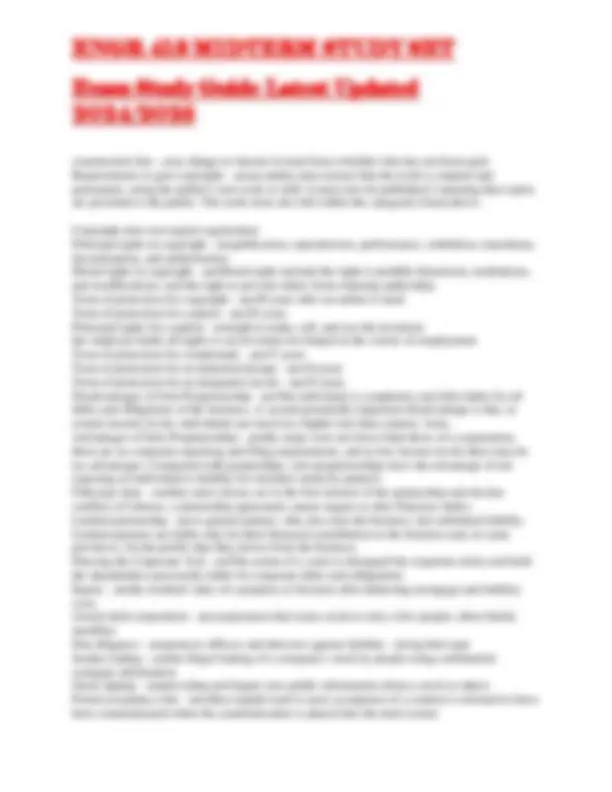
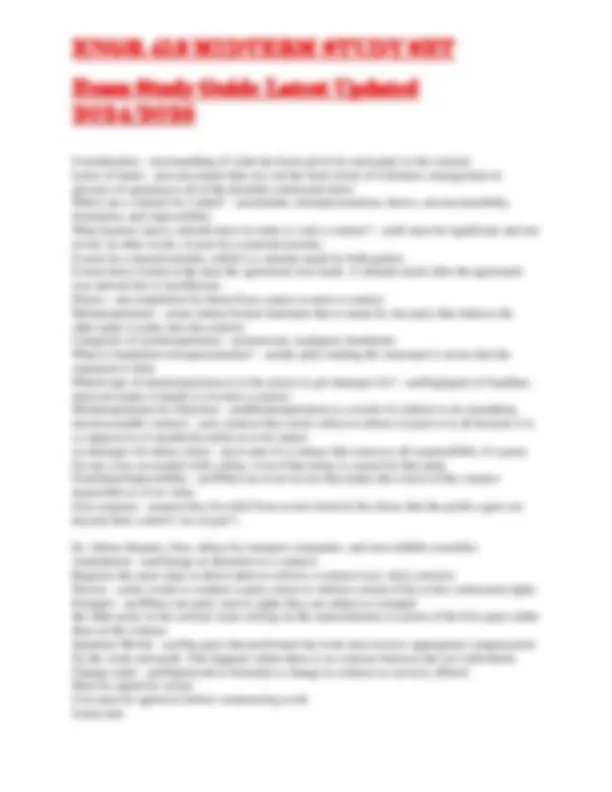
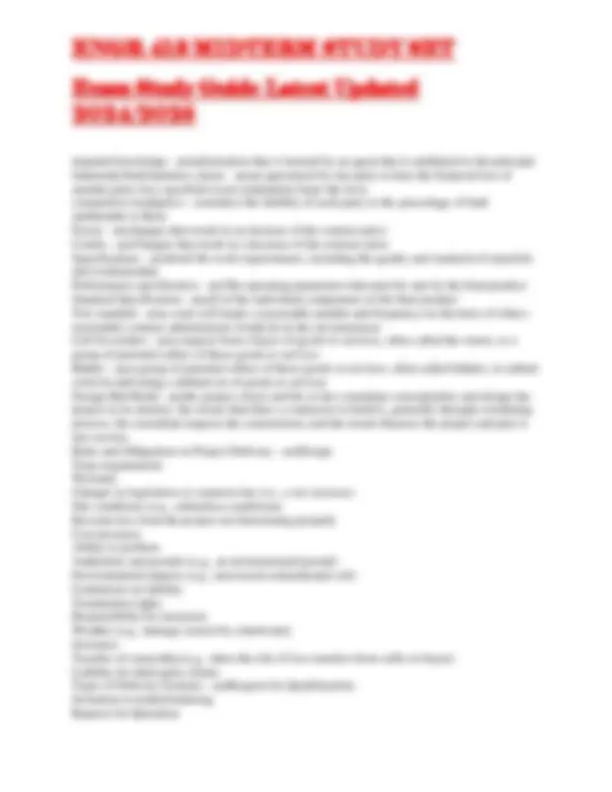
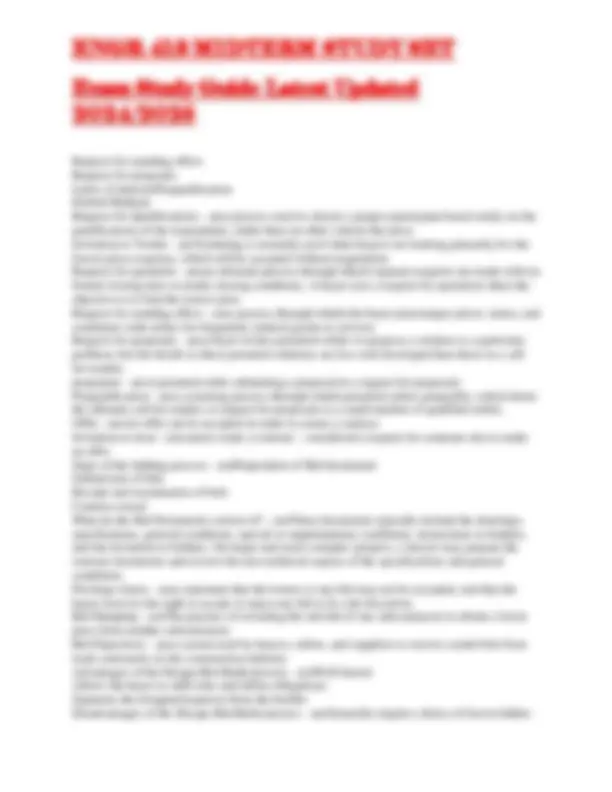
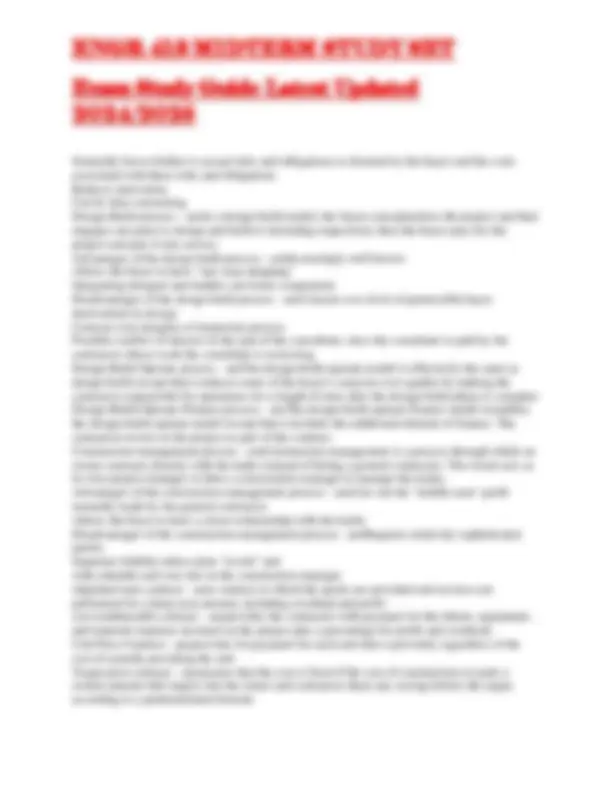



Study with the several resources on Docsity

Earn points by helping other students or get them with a premium plan


Prepare for your exams
Study with the several resources on Docsity

Earn points to download
Earn points by helping other students or get them with a premium plan
Community
Ask the community for help and clear up your study doubts
Discover the best universities in your country according to Docsity users
Free resources
Download our free guides on studying techniques, anxiety management strategies, and thesis advice from Docsity tutors
An overview of various legal concepts and contract management principles relevant to the construction industry. It covers topics such as property rights, contracts, negligence law, construction liens, risk allocation, contract interpretation, breach of contract, damages, and different types of construction delivery systems and contract structures. The document aims to equip readers with a comprehensive understanding of the legal and contractual aspects that govern construction projects, enabling them to navigate the complexities of the industry effectively. The content is structured in a way that addresses key questions and scenarios that construction professionals may encounter, making it a valuable resource for students, practitioners, and anyone interested in the legal and managerial aspects of the construction field.
Typology: Exams
1 / 13

This page cannot be seen from the preview
Don't miss anything!








Three primary features of the Constitution - ansDivision of powers, the creation of the courts, and the Canadian Charter of Rights and Freedoms What falls under federal jurisdiction? - ansnational defence, the postal service, broadcasting, criminal law, and specific fields such as patent law Patents and shipping disputes What falls under provincial jurisdiction? - ansMost areas of private law, such as property rights, contracts, negligence law, and construction liens
laws affecting architecture, engineering, and geo science practice fall under provincial jurisdiction. Which law prevails, provincial or federal? - ansFederal Competition Act - ansMatters such as bid rigging and unfair trade practices are governed by the Competition Act, which is a federal statute Which courts do each province have? - ansA trial court and court of appeal Trial Level Court - ansHas the same powers as the Court of Queens Bench Inherent Jurisdiction Judges are appointed by the governor general Inherent Jurisdiction - ansa concept based on the common law doctrine that a superior court has the authority to hear any matter that appears before it; may be overridden by statute or legislation What is the ultimate level of appeal? - ansSupreme Court How can you bring an appeal to the Supreme Court? - ansObtain leave from the supreme court by demonstrating that there is at least one matter of national importance Provincial Court - anslowest level of Canadian courts Provincial criminal courts and civil small claims court Small claims court - ansmaximum award amount $25, no jurisdiction over construction leins The charter - ansSection of the constitution that gives individual rights to all canadians and some non-citizens Applies to acts of the government but not between private parties Subordinate legislation - ansRegulations created by agencies (and any resultant entity) Common Law - ansLaws created by judges based off of British Law principles Civil Law - ansUsed by Qubec and Louisiana, based off of the Napoleonic Code of France All law is statute based Qubec Law - ansDictated by the Civil Code Characteristics of Construction Litigation - ansLarge # of parties involved Large # of documents produced that are relevant to the case What should an unpaid subcontractor do in the case of an insolvency dispute? - ansFile a lien or assert a claim against a labor and material payment bond Lien - ansa right to keep possession of property belonging to another person until a debt owed by that person is discharged. Limitation period - ansthe period of time within which legal action must be taken
How can parties in a project allocate risk to minimize it for themselves? - ansDesign contracts to allocate risks between the parties Use insurance to shift risk to the insurer Use bonds to protect parties from risk of non-performance or non-payment Include contractual disclaimers to shift risk Contract - ansVoluntary agreements between two or more parties that set out the rights, responsibilities, and liabilities of the parties to each other. Tort - ansActs comitted by one party in violation to the rights of another party Negligence claim - ansAsserted by a party who has been injured, either financially or physically, by the act or omission of another party You do not need a contractual relationship to file a negligence claim Right to Title - ansThe professional regularity authority can regulate the exclusive right for its members to use a particular title Protected by the regulatory bodies through discipline and enforcement proceedings Scope of practice - ansno one can practise within the exclusive scope of practice of these professions without being licensed Principal functions of professional regulatory bodies - ansregister members, regulate the practice of its members, discipline members, and enforce the legislation against non-members who are practising illegally Obligations of a professional - ansPractice their profession competently and in accordance to the code of ethics of their regulatory body Continue professional development Practice audits Dicipline - ansCharging a member and proceeding to a hearing to determine guilt Enforcement - ansthe process of charging a non-member with either using the protected professional title in breach of the right to title or practising the profession in breach of the exclusive scope of practice Penalties for Dicipline - ansreprimands, suspensions, fines, termination of licences, educational requirements, and mentor- ship requirements quasi-criminal reciprocity agreements - ansAgreements that exist between places that have licensing requirements Which title can a graduate engineering student take - ansno title until they are in an apprentenship Conflict of Interest - ansa situation in which the professional has conflicting obligations to the public, the client, the employer, the profession, or him- or herself Categories of consequences - ansCriminal- imprisonment (most severe) civil - monetary damages discipline - loss of professional status
construction lien - ansa charge or interest in land from a builder who has not been paid Requirements to gain copyright - ansan author must ensure that the work is original and permanent, using the author's own work or skill. It must also be published,3 meaning that copies are provided to the public. The work must also fall within the categories listed above.
Copyright does not require registration Principal rights in copyright - anspublication, reproduction, performance, exhibition, translation, dissemination, and authorization Moral rights in copyright - ansMoral rights include the right to prohibit distortions, mutilations, and modifications, and the right to prevent others from claiming authorship Term of protection for copyright - ans50 years after an author is dead Term of protection for a patent - ans20 years Principal rights for a patent - ansright to make, sell, and use the invention the employer holds all rights to an invention developed in the course of employment Term of protection for a trademark - ans15 years Term of protection for an industrial design - ans10 years Term of protection for an integrated circuit - ans10 years Disadvantages of Sole Proprietorship - ansThe individual is completely and fully liable for all debts and obligations of the business. A second potentially important disadvantage is that, at certain income levels, individuals are taxed at a higher rate than corpora- tions. Advantages of Sole Proprietorship - ansthe setup costs are lower than those of a corporation, there are no corporate reporting and filing requirements, and at low income levels there may be tax advantages. Compared with partnerships, sole proprietorships have the advantage of not exposing an individual to liability for mistakes made by partners Fidicuary duty - ansthey must always act in the best interest of the partnership and declare conflicts of interest. a partnership agreement cannot negate or alter fiduciary duties. Limited partnership - ansA general partner, who also runs the business, has unlimited liability. Limited partners are liable only for their financial contribution to the business and, in some provinces, for the profits that they derive from the business Piercing the Corporate Veil - ansThe action of a court to disregard the corporate entity and hold the shareholders personally liable for corporate debts and obligations. Equity - ansthe residual value of a property or business after deducting mortgage and liability costs closely held corporation - anscorporation that issues stock to only a few people, often family members Due diligence - ansprotects officers and directors against liability - doing their part Insider trading - ansthe illegal trading of a company's stock by people using confidential company information Stock tipping - ansproviding privileged, non-public information about a stock to others Postal acceptance rule - answhen regular mail is used, acceptance of a contract is deemed to have been communicated when the communication is placed into the mail system
Consideration - anssomething of value has been given by each party to the contract Letter of intent - ansa document that sets out the basic terms of a business arrangement in advance of agreeing to all of the detailed contractual terms When can a contract be voided? - ansmistake, misrepresentation, duress, unconscionability, frustration, and impossibility What features must a mistake have in order to void a contract? - ansIt must be significant and not trivial. In other words, it must be a material mistake. It must be a mutual mistake, which is a mistake made by both parties. It must have existed at the time the agreement was made. A mistake made after the agreement was entered into is insufficient. Duress - anscompulsion by threat from a party to enter a contract Misinterpretation - ansan untrue factual statement that is made by one party that induces the other party to enter into the contract Categories of misinterpretation - ansinnocent, negligent, fraudulent What is fraudulent misrepresentation? - ansthe party making the statement is aware that the statement is false Which type of misinterpretation is it the easiest to get damages for? - ansNegligent or fraudlent, innocent makes it harder to rescind a contract Misinterpretation by Omission - ansMisinterpretation as a result of a failure to do something unconscionable contract - ansa contract that courts refuse to enforce in part or at all because it is so oppressive or manifestly unfair as to be unjust no-damages-for-delay clause - ansA part of a contract that removes all responsibility of a party for any costs associated with a delay, even if that delay is caused by that party. Frustraton/Impossibility - ansWhen an event occurs that makes the course of the contract impossible or of no value force majeure - ansprovides for relief from events listed in the clause that the parties agree are beyond their control ("act of god")
Ex. labour disputes, fires, delays by transport companies, and unavoidable casualties Amendment - ansChange or alteration to a contract Requires the same steps as those taken to enforce a contract (see: mini contract) Waiver - ansby words or conduct a party ceases to enforce certain of his or her contractual rights Estoppel - ansWhen one party waives rights they are subject to estoppel the other party in the contract starts relying on the representation or action of the first party rather than on the contract Quantum Meruit - ansThe party that performed the work must recieve appropriate compensation for the work and profit. This happens where there is no contract between the two individuals Change order - ansPaperwork to formalize a change in contract or services offered Must be signed by owner Cost must be agreed to before commencing work Lump sum
Penalty - ansa sum of money included in a contract as punishment for breach of the contract rather than as compensation for the breach Bonus Clause - ansA contract provision that provides an incentive payment for exemplary performance What events can cause contract termination? - ansFundamental and simple breaches Repudiation and Anticipatory Breach Termination Clauses Fundamental breach - ansa breach of the contract that goes to the root of the agreement Simple breach - ansA breach that does not warrant the termination of a contract. The only remedy is to sue for damages Repudiation - answhere one party, by words or conduct, lets the other party know that it does not intend to perform its obligations. Repudiation without justification constitutes a fundamental breach What does repudiation without justification constitute? - ansA fundamental breach Anticipatory breach - ansone party communicates to the other party before the time for performance of an obligation that he or she intends to breach that obligation of the contract Termination Clause - anslists the acts by either party that entitle the other party to terminate the contract Termination for convenience clause - ansmay be used by the owner or, in some cases, by either party to terminate the contract without cause or reason. In some cases, such clauses will require that the non-terminating party be paid a termination sum or lost profit. Objective Standard - ansdetermining what hypothetical reasonable parties would have intended Subjective standard - ansdetermining what the actual parties themselves intended Canons of Contract Construction - ansPlain and ordinary meaning Special Meaning Reading the contract as a whole Giving effect to all parts of a contract Restriction by express provisions Commercial purpose Context Contra Proferentem What does restriction by express provisions mean? - ansAssigning greater importance to special clauses or sections Parol Evidence Rule - answhere a contract is entirely written and is clear and unambiguous, extrinsic evidence is not admissible to add to, vary, or contradict the written words Agent - ansA person authorized to act on behalf of another party known as the principal Three parts of an agency relationship - ansPrincipal, agent, third party How can a principal provide authority to an agent? - ansEither by express or apparent authority Express/actual authority - ansAuthority conveyed by the principal in words (oral or written). Apparent/ostensible/implied authority - ansrepresentations made by the principal to the third party
imputed knowledge - ansinformation that is learned by an agent that is attributed to the principal Indemnity/hold harmless clause - ansan agreement by one party to bear the financial loss of another party for a specified event (indemnitor bears the loss) comparitive negligence - ansreduce the liability of each party to the percentage of fault attributable to them Extras - anschanges that result in an increase of the contract price Credits - ansChanges that result in a decrease of the contract price Specifications - ansdetail the work requirements, including the quality and standard of materials and workmanship Performance specification - ansThe operating parameters that must be met by the final product Standard Specification - ansall of the individual components of the final product Tort standard - ansa court will imply a reasonable number and frequency on the basis of what a reasonable contract administrator would do in the circumstances Call for tenders - ansa request from a buyer of goods or services, often called the owner, to a group of potential sellers of those goods or services Bidder - ansa group of potential sellers of those goods or services, often called bidders, to submit a bid for delivering a defined set of goods or services Design-Bid-Build - ansthe project owner and his or her consultant conceptualize and design the project in its entirety. the owner then hires a contractor to build it, generally through a tendering process; the consultant inspects the construction; and the owner finances the project and puts it into service. Risks and Obligations in Project Delivery - ansDesign Time requirements Warranty Changes in legislation or common law (i.e., a tax increase) Site conditions (e.g., subsurface conditions) Revenue loss from the project not functioning properly Cost increases Ability to perform Authorities and permits (e.g., an environmental permit) Environmental impacts (e.g., uncovered contaminated soil) Limitations on liability Termination rights Responsibility for insurance Weather (e.g., damage caused by a hurricane) Insurance Transfer of ownership (e.g., when the risk of loss transfers from seller to buyer) Liability for third-party claims Types of Delivery Systems - ansRequest for Qualifications Invitation to tender/tendering Request for Quotation
Generally forces bidder to accept risks and obligations as dictated by the buyer and the costs associated with these risks and obligations Reduces innovation Can be time consuming Design-Build process - ansIn a design-build model, the buyer conceptualizes the project and then engages one party to design and build it (including inspection); then the buyer pays for the project and puts it into service Advantages of the design build process - ansIncreasingly well known Allows the buyer to have "one-stop shopping" Integrating designer and builder can foster cooperation Disadvantages of the design build process - ansConcern over level of permissible buyer intervention in design Concern over integrity of inspection process Possible conflict of interest on the part of the consultant, since the consultant is paid by the contractor whose work the consultant is reviewing Design Build Operate process - ansThe design-build-operate model is effectively the same as design-build except that it reduces some of the buyer's concerns over quality by making the contractor responsible for operations for a length of time after the design-build phase is complete Design-Build-Operate-Finance process - ansThe design-build-operate-finance model resembles the design-build-operate model except that it includes the additional element of finance. The contractor invests in the project as part of the contract. Construction management process - ansConstruction management is a process through which an owner contracts directly with the trades instead of hiring a general contractor. The owner acts as its own project manager or hires a construction manager to manage the trades. Advantages of the construction management process - ansCuts out the "middle man" profit normally made by the general contractor Allows the buyer to have a closer relationship with the trades Disadvantages of the construction management process - ansRequires relatively sophisticated parties Separates liability unless done "at risk" and with schedule and cost risk on the construction manager stipulated sum contract - ansa contract in which the goods are provided and services are performed for a lump sum amount, including overhead and profit cost reimbursable contract - ansprovides the contractor with payment for the labour, equipment, and material expenses incurred on the project plus a percentage for profit and overhead, Unit Price Contract - ansprovides for payment for each unit that is provided, regardless of the cost of actually providing the unit Target price contract - ansensures that the cost is fixed if the cost of construction exceeds a certain amount (the target); but the owner and contractor share any savings below the target, according to a predetermined formula
Guaranteed Maximum Price Contract - ansrequire the contractor to absorb all costs of construction above the target Design Build Contract - ansin a design-build contract, the owner generally contracts out the design, construction, and inspection, often to a single party Crucial elements of an alliance agreement - ansa "no blame" clause (perhaps with some limited exceptions), which operates between all of the parties, including the owner a clearly defined gainshare/painshare a clear understanding of the roles of the participants Grubstake agreement - ansan agreement between a store owner (who provided grub) and the prospector so that the prospector did not starve while searching for a big strike. Option agreement - ansprovide the optionee (the party purchasing the option) with the right to buy or not buy land, goods, or rights from the optionor (the party granting the option). Standard clauses of a contract - ansScope of work Contract Time Changes Damages and bonuses Warranty Termination indemnification Exclusion, limitation, or Waiver Clauses Exclusion clause - ansa clause that purports to completely exclude the damages or remedies available to the innocent party upon the occurrence of specified events. Limitation clauses - anspurport to contain or limit the damages or remedies available to the innocent party upon the occurrence of specified events dispute resolution provision - ansa clause that defines the process to be followed in resolving disputes between the parties to a contract notice of claim provision - ansa clause that defines the process to be followed for giving notice of and information in respect of a claim under a contract Bankable contract - ansHas terms acceptable to the lender financing one of the project participants How long is the time limit for commencing a legal action from the breach in British Columbia? - ans2 years What is the most serious disadvantage of the Arbitration? - ansConsequences resulting from third-party claims What claims does a claims-made policy cover? - ansclaims made during the policy period How long is the "ultimate" limitation period that prevents claims for latent defects? - ans10- years depending on the statute How can you perfect a lein? - ansCommence a legal action and prove the lien Under the trust provision of a construction lien statute, who is the trustee? - ansThe contractor What are the terms of the three parties involved in a suretyship agreement? - ansPrincipal, surety, obligee
Arbitration - ansa private litigation or trial process in which the parties set the rules and choose the judge, called the arbitrator Litigation - ansThe use of a court system to settle a dispute Disadvantages of litigation - ansMoney, Time, winner takes all, method of last resort Pleadings - ansPleadings include the statement of claim, statement of defence, reply, demand for particulars, interrogatories, and motions. Statement of Claim/Writ - ansThe document identifies the parties, the allegations that form the basis of the claim, a cause of action, and the nature of the relief sought Which party files the statement of claim? - ansThe plaintiff Discovery - ansprocedures available to all parties prior to trial, including but not limited to examination for discovery, interrogatories, inspection of property, and disclosure of documents. Discovery of documents - ansthe ongoing process of identifying documents that are relevant to the litigation. continues until shortly before trial Arbitrator - ansPrivate judge mandatory binding arbitration - ansa mandatory arbitration clause voluntary binding arbitration - ansparties agree to arbitration after a dispute has arisen non-binding arbitration - ansthe arbitrator's decision is merely advisory Mediation - ansan assisted negotiation process in which a neutral third party facilitates settlement discussions Settlement conference - ansan informal meeting or, in some jurisdictions, a formal mediation process with a judge. The judge's role is to assist the parties to settle the case before litigation.